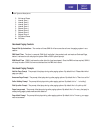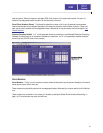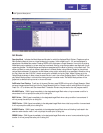
Extension The name of this block. A Block name can be any alphanumeric string up to 16 characters long (includ-
ing spaces). A Block name may not be the same as another Block name. MBX, EXT or LIST Numbers may not be
duplicated within the same group.
SVMi-8 stores the subscriber name in 'last name, firstname' field. When entering the subscriber name this format
should be followed. If the name is entered as 'firstname, lastname' SVMi-8 will automatically re-sort it to 'lastname,
firstname'.
This format is only important because the directory feature will search on a specific field (first name or lastname) and
the search should be consistent for all entries.
Extension Number The number that must be entered by the caller in order to access the subscriber extension. It
does not necessarily have to be the same number dialed by SVMi-8 when transferring to the extension on the tele-
phone system. This can not be the same number of any other extension.
Account Code Entered if the subscriber has an access code used for long distance access. This access code can be
inserted in any dial string using '$A'.
Mailbox The mailbox corresponding to the subscriber Extension Block. Press ENTER to bring up the Target
Generator. Select and open the appropriate block type from the Target Generator pick list. Choose a new or existing
block of that type and press ENTER. Press ‘Ctrl+O’ at this field to review or edit the Mailbox Block or Distribution
List associated with the Block.
Eclass The name of the Eclass block that contains the class of service information for this Extension. Much of the
prompts, control, and parameters are located here. See the EClass Block for detailed information and operation.
Press Ctrl + 'O' (Open) at this field to review or edit the ECLASS Block associated with the Extension.
To change this entry, press ENTER to bring up the Target Generator. Select a new or existing Block.
Extension Controls
Dial Number The actual number that the SVMi-8 will dial to complete the transfer. SVMi-8 associates two types of
numbers with an extension: the block identification number called the Key and the Dial Number. The Key is the num-
ber the caller enters for a particular called party's telephone. The Dial Number is the number the telephone system
database recognizes as one of its stations. When the SVMi-8 receives the Key from the caller, it transmits the Dial
Number to the telephone system to execute the transfer to the called party's telephone.
The Key and the Dial Number are usually the same, but they can be different. When they are different, the extension
is a virtual extension. A virtual extension can be configured with the same set of call automation attributes as a regu-
lar extension. It is particularly useful when a group of people in an organization share a single telephone. Each per-
son in the group can be assigned his own Key in the SVMi-8 subscriber database. The Dial Number, however, will be
the same for each virtual extension. This allows callers to enter a distinctive Key for each member of the group, even
though they ring the same telephone. A call presentation prompt can be customized for each virtual extension sub-
scriber; for example, "Call for John Smith," or "Call for Jane Doe".
Alternate Number The SVMi-8 has a feature where a subscriber can enter an alternate location and all calls
processed by the extension block will be transferred to this alternate number. This number can be an internal number
(other extension) or an external number like your home number.
The Designated location option must be set to Yes to use this feature. When calls are transferred to a designated
location (alternate number) the SVMi-8 will supervise the transfer, i.e. it will monitor the call progress until the call is
Block Types and Descriptions
48


















